PENN YAN, NY: OCT. 6, 1912 – Late at night, smoke seeped into an upstairs bedroom in a home near Keuka Landing. The woman of the house, Mrs. Stowell, was awaken by shrieks of “Fire! Fire!” Her parrot was hopping around inside his cage and squawking loudly in response to the invading clouds of smoke. Leaping from bed, the woman had just enough time to snap up the cage and flee into the night before flames reached her room. She then called neighbors, who formed a bucket brigade and stopped the flames that were extending toward a schoolhouse and nearby general store. The parrot was credited to saving not only his owner, but the entire town.
TARRYTOWN, NY: OCT. 16, 1912 – Flames raced through a four-story tenement building, trapping many people inside. Arriving firemen faced an advanced fire situation with very little water pressure. As they struggled to make rescues, an automobile was dispatched to the pumping station to increase the water pressure. When the flames were finally extinguished and the smoke cleared, 79 women and children were left homeless, two young girls were dead and a mother and child were hospitalized, both in critical condition.
PASSAIC, NJ: OCT. 16, 1912 – At 4:30 A.M., flames broke out in the four-story meatpacking plant of the Henry Muhs Co. at Monroe Street and Central Avenue. As the fire began to take hold of the building, 28 horses were led out of the stable on the Central Avenue side and a woman was found lost in the smoke in a second-floor room. Flames quickly engulfed the huge plant and firefighters were further endangered as several ammonia tanks inside exploded, toppling walls outward.
NEW YORK CITY: OCT. 16, 1912 – A fire that started at 7 P.M. inside a kindling mill on 128th Street between First and Second avenues destroyed the mill and all the lumber stored in the yards within 90 minutes. Aggressive firefighting protected the exposures as waves of radiant heat threatened a large grain mill and nearby stables. As the third alarm was transmitted, responding companies found it difficult to move into position due to the throng of spectators who had been drawn to the huge fire. It was estimated that nearly 100,000 people descended on the fire scene. Police reserves responded from four stations to control the crowds.
BENICIA, CA: OCT. 18, 1912 – The main storehouse of the Benicia Arsenal at the U.S. military reservation was the site of a huge fire that burned an estimated $1 million in munitions and the buildings housing the explosives. The following day, fire still glowed in the vaults and cellars of the old building, which had served since 1857 as the arms factory and supply station for the Pacific Coast and the Orient. Spontaneous combustion produced by chemical disintegration of nitro powder was believed to have caused the fire.
LYNBROOK, NY: OCT. 26, 1912 – The First Methodist Episcopal Church on Merrick Road was destroyed by a fire in the early morning. Investigators and church officials believed the fire was the work of thieves, who apparently forced their way into the church to steal a newly rolled carpet worth $500. The church had been undergoing renovations and the new carpet had just arrived. The pastor, who lived across the street, discovered the fire and noticed a panel broken out of the church’s side door. The flames destroyed the wooden church.
LAWRENCEVILLE, NJ: OCT. 27, 1912 – Crossed electrical wires were believed to have ignited a blaze on the third floor of the Griswold House at Lawrenceville School. The building was the site of a Halloween party when the fire was discovered. Thirty students safely evacuated the building, but one professor was badly burned and his assistant was overcome by the heavy smoke. The fire was held to the third floor.
BROOKLYN, NY: OCT. 30, 1912 – For close to a week, a dozen boys had been busy digging a cave in a vacant lot on Hopkinson Avenue near Fulton Street. They had just placed a door across the opening to allow them to crawl inside the cave. It was just after 8 A.M. when the roof of the cave collapsed, trapping several children and scattering others who ran away in terror. The fire alarm box was pulled and Ladder 173 responded quickly. The firemen began digging frantically and uncovered two young boys ages 9 and 12. Sadly, the boys could not be revived. Digging continued looking for several additional boys who were believed trapped, but were later found safe.
SAN ANTONIO, TX: OCT. 30, 1912 – Five Sisters of Charity gave up their lives to save the 87 children in their care when a fire swept the St. John’s Orphanage during the early-morning hours. A small boy on his way to the bathroom saw the fire and raised the alarm. The Sisters hurried around the building, waking children and hustling them outside. As the fire grew, they continued to re-enter the heavy smoke searching for missing children. Faced with a fierce fire and people trapped Fire Chief Wright, who arrived with the first apparatus, split his men into two teams: rescue and firefighting. Suddenly, a nun appeared in an upper-floor window with a child in her arms. A ladder was raised, but as the chief ascended the figure fell back into the smoke and fire filled the window. Later, she was found, the child still in her arms, among the charred rubble. When the fire was finally extinguished, the death toll was determined to be the five nuns and three children. A tragic toll indeed, but a testament to the bravery of the Sisters who saved 84 other children.






